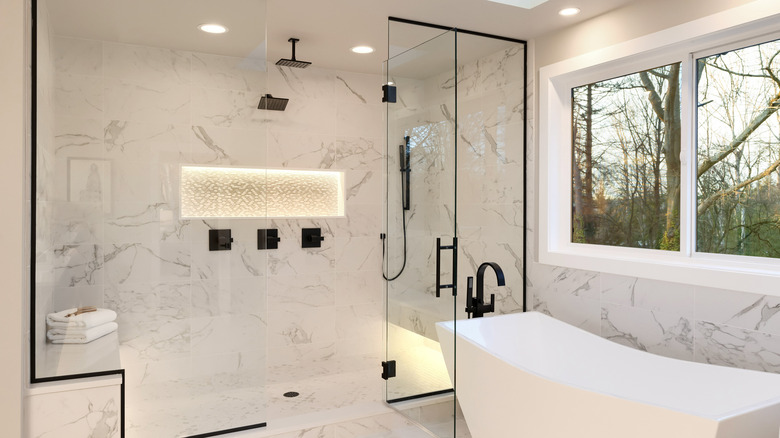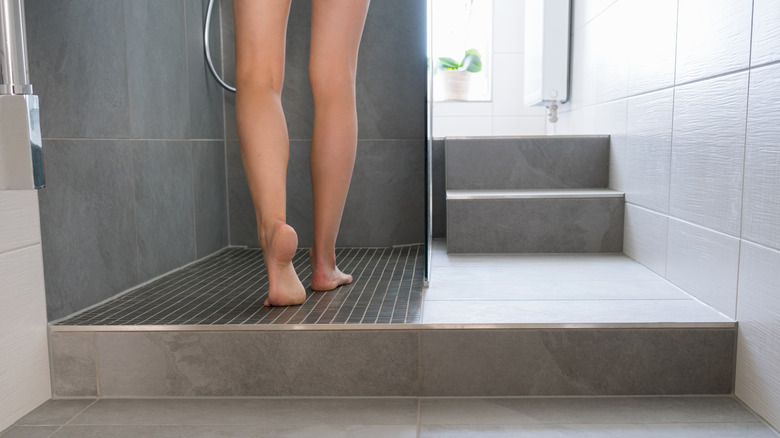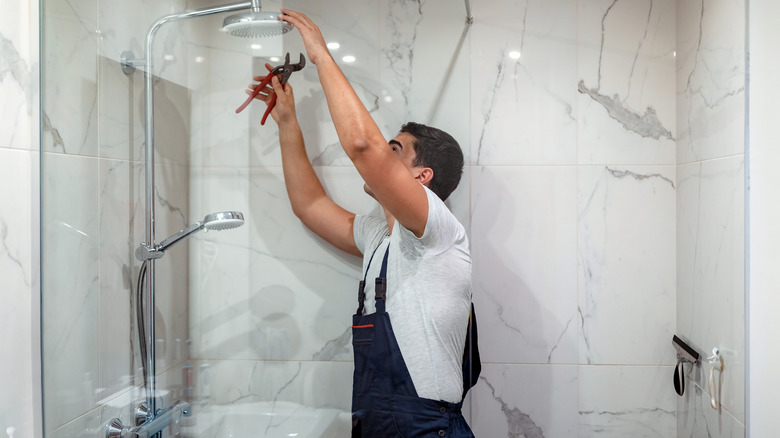Why You Might Want To Think Twice About Putting A Walk-In Shower In Your Bathroom
If you spend any time at all perusing interior design sites, you'll see that the newest luxury bathroom trend is the coveted walk-in shower. Instead of the traditional stand-alone or shower-bath combo, walk-ins function almost as a mini wet room, as they are usually large and have plenty of floor space. Many add rainfall shower heads, steam options, and accent door features, which make for a totally luxe experience. For those who savor their showers as the best part of their day, the walk-in probably seems like a no-brainer, but unfortunately, there are some major downsides to this high-end shower trend.
While the curbless, barrier-free walk-in model is meant to make it easier to get in and out of the shower (a huge benefit for those with mobility disabilities), it can also cause major flooding issues, which can be compounded by inadequate ventilation. Without a barrier, there's nothing to stop the water from the shower from spreading elsewhere in the bathroom, which can cause a myriad of issues. Plus, it takes a lot of shower steam to heat such a large area, which may not be ideal when it comes to showering on a cold winter morning.
Why is drainage such an issue?
You might accept that a wet floor is just one of the trade-offs of having a walk-in shower. But it's not just the slipping hazard you should be aware of, though that is certainly something to keep in mind as well. When water leaks out of the shower, it doesn't usually evaporate straight away, especially if it's in contact with porous surfaces, such as painted walls, wooden baseboards, peel-and-stick vinyl tile, and more. The accumulation of water on these moisture-retaining surfaces can damage the finish by causing the paint to peel, the flooring to bubble up, and so on.
Beyond that, it also creates a perfect breeding environment for bacteria, mildew, and mold. This can become an even bigger issue if there isn't a strong enough ventilation system. All of those fancy steaming gadgets and luxurious hour-long showers make for more water in the air, so it's essential to have a solid bathroom fan, or else you'll run into the same issues as the flooded floor. To deal with the floor flooding, you can try adding a taller curb than is standard, but this sort of defeats the purpose of the walk-in, both aesthetically and functionally. Alternatively, you can build the shower on a gradual incline so the water pools into the drain, but expect to dish out some cash for a contractor to do the job right.
It can get pricy quickly
You should also consider how comfortable it will actually be in your shower most days out of the year. If you live in an area with cold temperatures, it's likely your walk-in shower will be quite cold, and won't heat up immediately. That means you'll mostly want to stay directly under the water to stay warm, and you'll probably have drafty cold spots in the shower. To combat this in the long term, you'll need to invest in some heavy-duty insulation, which may make the renovation more costly and extensive, as it requires wall demolition. If you've got deep pockets, you might also consider installing a heated shower floor, but expect a shattered renovation budget.
On the topic of unexpected costs, give those steam wands and bonus showerheads a second thought. Though they are luxurious, they will probably require re-routed plumbing systems — which we wouldn't describe as a particularly easy task for amateur DIYers. So unless you're fairly experienced in bathroom renovations, there's a good chance you will need to pay for both the materials and the labor of the walk-in shower with professional help. At the end of the day, turning your bathroom into a spa with a walk-in shower might not be as worth it as you once thought.


